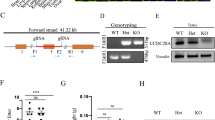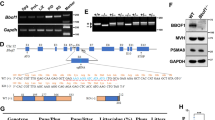Abstract
Cullin-RING E3 ubiquitin ligase (CRL)-4 is a member of the large CRL family in eukaryotes. It plays important roles in a wide range of cellular processes, organismal development, and physiological and pathological conditions. DDB1- and CUL4-associated factor 8 (DCAF8) is a WD40 repeat-containing protein, which serves as a substrate receptor for CRL4. The physiological role of DCAF8 is unknown. In this study, we constructed Dcaf8 knockout mice. Homozygous mice were viable with no noticeable abnormalities. However, the fertility of Dcaf8-deficient male mice was markedly impaired, consistent with the high expression of DCAF8 in adult mouse testis. Sperm movement characteristics, including progressive motility, path velocity, progressive velocity, and track speed, were significantly lower in Dcaf8 knockout mice than in wild-type (WT) mice. However, the total motility was similar between WT and Dcaf8 knockout sperm. More than 40% of spermatids in Dcaf8 knockout mice showed pronounced morphological abnormalities with typical bent head malformation. The acrosome and nucleus of Dcaf8 knockout sperm looked similar to those of WT sperm. In vitro tests showed that the fertilization rate of Dcaf8 knockout mice was significantly reduced. The results demonstrated that DCAF8 plays a critical role in spermatogenesis, and DCAF8 is a key component of CRL4 function in the reproductive system.
Similar content being viewed by others
References
Neto FT, Bach PV, Najari BB, Li PS, Goldstein M. Genetics of male infertility. Curr Urol Rep 2016; 17(10): 70
Schlegel PN. Evaluation of male infertility. Minerva Ginecol 2009; 61(4): 261–283
O’Flynn O’Brien KL, Varghese AC, Agarwal A. The genetic causes of male factor infertility: a review. Fertil Steril 2010; 93(1): 1–12
Krausz C. Male infertility: pathogenesis and clinical diagnosis. Best Pract Res Clin Endocrinol Metab 2011; 25(2): 271–285
Eddy EM. Male germ cell gene expression. Recent Prog Horm Res 2002; 57(1): 103–128
de Kretser DM, Loveland KL, Meinhardt A, Simorangkir D, Wreford N. Spermatogenesis. Hum Reprod 1998; 13(Suppl 1): 1–8
Schultz N, Hamra FK, Garbers DL. A multitude of genes expressed solely in meiotic or postmeiotic spermatogenic cells offers a myriad of contraceptive targets. Proc Natl Acad Sci USA 2003; 100(21): 12201–12206
Hou CC, Yang WX. New insights to the ubiquitin-proteasome pathway (UPP) mechanism during spermatogenesis. Mol Biol Rep 2013; 40(4): 3213–3230
Baarends WM, van der Laan R, Grootegoed JA. Specific aspects of the ubiquitin system in spermatogenesis. J Endocrinol Invest 2000; 23(9): 597–604
Kopanja D, Roy N, Stoyanova T, Hess RA, Bagchi S, Raychaudhuri P. Cul4A is essential for spermatogenesis and male fertility. Dev Biol 2011; 352(2): 278–287
Ma T, Keller JA, Yu X. RNF8-dependent histone ubiquitination during DNA damage response and spermatogenesis. Acta Biochim Biophys Sin (Shanghai) 2011; 43(5): 339–345
Wang S, Zheng H, Esaki Y, Kelly F, Yan W. Cullin3 is a KLHL10-interacting protein preferentially expressed during late spermiogenesis. Biol Reprod 2006; 74(1): 102–108
Lu LY, Wu J, Ye L, Gavrilina GB, Saunders TL, Yu X. RNF8-dependent histone modifications regulate nucleosome removal during spermatogenesis. Dev Cell 2010; 18(3): 371–384
Petroski MD, Deshaies RJ. Function and regulation of Cullin-RING ubiquitin ligases. Nat Rev Mol Cell Biol 2005; 6(1): 9–20
Jackson S, Xiong Y. CRL4s: the CUL4-RING E3 ubiquitin ligases. Trends Biochem Sci 2009; 34(11): 562–570
O’Connell BC, Harper JW. Ubiquitin proteasome system (UPS): what can chromatin do for you? Curr Opin Cell Biol 2007; 19(2): 206–214
Zhong W, Feng H, Santiago FE, Kipreos ET. CUL-4 ubiquitin ligase maintains genome stability by restraining DNA-replication licensing. Nature 2003; 423(6942): 885–889
Sugasawa K. The CUL4 enigma: culling DNA repair factors. Mol Cell 2009; 34(4): 403–404
Cheng J, Guo J, North BJ, Tao K, Zhou P, Wei W. The emerging role for Cullin 4 family of E3 ligases in tumorigenesis. Biochim Biophys Acta Rev Cancer 2019; 1871(1): 138–159
Wang H, Zhai L, Xu J, Joo HY, Jackson S, Erdjument-Bromage H, Tempst P, Xiong Y, Zhang Y. Histone H3 and H4 ubiquitylation by the CUL4-DDB-ROC1 ubiquitin ligase facilitates cellular response to DNA damage. Mol Cell 2006; 22(3): 383–394
Lee J, Zhou P. DCAFs, the missing link of the CUL4-DDB1 ubiquitin ligase. Mol Cell 2007; 26(6): 775–780
Angers S, Li T, Yi X, MacCoss MJ, Moon RT, Zheng N. Molecular architecture and assembly of the DDB1-CUL4A ubiquitin ligase machinery. Nature 2006; 443(7111): 590–593
Yin Y, Liu L, Yang C, Lin C, Veith GM, Wang C, Sutovsky P, Zhou P, Ma L. Cell autonomous and nonautonomous function of CUL4B in mouse spermatogenesis. J Biol Chem 2016; 291(13): 6923–6935
Lin CY, Chen CY, Yu CH, Yu IS, Lin SR, Wu JT, Lin YH, Kuo PL, Wu JC, Lin SW. Human X-linked intellectual disability factor CUL4B is required for post-meiotic sperm development and male fertility. Sci Rep 2016; 6(1): 20227
Yin Y, Lin C, Kim ST, Roig I, Chen H, Liu L, Veith GM, Jin RU, Keeney S, Jasin M, Moley K, Zhou P, Ma L. The E3 ubiquitin ligase Cullin 4A regulates meiotic progression in mouse spermatogenesis. Dev Biol 2011; 356(1): 51–62
Ali A, Mistry BV, Ahmed HA, Abdulla R, Amer HA, Prince A, Alazami AM, Alkuraya FS, Assiri A. Deletion of DDB1- and CUL4-associated factor-17 (Dcaf17) gene causes spermatogenesis defects and male infertility in mice. Sci Rep 2018; 8(1): 9202
Wu Y, Zhou L, Wang X, Lu J, Zhang R, Liang X, Wang L, Deng W, Zeng YX, Huang H, Kang T. A genome-scale CRISPR-Cas9 screening method for protein stability reveals novel regulators of Cdc25A. Cell Discov 2016; 2(1): 16014
Nowak M, Suenkel B, Porras P, Migotti R, Schmidt F, Kny M, Zhu X, Wanker EE, Dittmar G, Fielitz J, Sommer T. DCAF8, a novel MuRF1 interaction partner, promotes muscle atrophy. J Cell Sci 2019; 132(17): jcs233395
Li G, Ji T, Chen J, Fu Y, Hou L, Feng Y, Zhang T, Song T, Zhao J, Endo Y, Lin H, Cai X, Cang Y. CRL4DCAF8 ubiquitin ligase targets histone H3K79 and promotes H3K9 methylation in the liver. Cell Rep 2017; 18(6): 1499–1511
Huang D, Liu C, Sun X, Sun X, Qu Y, Tang Y, Li G, Tong T. CRL4DCAF8 and USP11 oppositely regulate the stability of myeloid leukemia factors (MLFs). Biochem Biophys Res Commun 2020; 529(2): 127–132
Klein CJ, Wu Y, Vogel P, Goebel HH, Bönnemann C, Zukosky K, Botuyan MV, Duan X, Middha S, Atkinson EJ, Mer G, Dyck PJ. Ubiquitin ligase defect by DCAF8 mutation causes HMSN2 with giant axons. Neurology 2014; 82(10): 873–878
Gou LT, Dai P, Yang JH, Xue Y, Hu YP, Zhou Y, Kang JY, Wang X, Li H, Hua MM, Zhao S, Hu SD, Wu LG, Shi HJ, Li Y, Fu XD, Qu LH, Wang ED, Liu MF. Pachytene piRNAs instruct massive mRNA elimination during late spermiogenesis. Cell Res 2015; 25 (2): 266
Gou LT, Kang JY, Dai P, Wang X, Li F, Zhao S, Zhang M, Hua MM, Lu Y, Zhu Y, Li Z, Chen H, Wu LG, Li D, Fu XD, Li J, Shi HJ, Liu MF. Ubiquitination-deficient mutations in human Piwi cause male infertility by impairing histone-to-protamine exchange during spermiogenesis. Cell 2017; 169(6):1090–1104.e13
Livak KJ, Schmittgen TD. Analysis of relative gene expression data using real-time quantitative PCR and the 2(− ΔΔC(T)) method. Methods 2001; 25(4): 402–408
Shechter D, Dormann HL, Allis CD, Hake SB. Extraction, purification and analysis of histones. Nat Protoc 2007; 2(6): 1445–1457
Quinn P, Kerin JF, Warnes GM. Improved pregnancy rate in human in vitro fertilization with the use of a medium based on the composition of human tubal fluid. Fertil Steril 1985; 44(4): 493–498
Chen Q, Peng H, Lei L, Zhang Y, Kuang H, Cao Y, Shi QX, Ma T, Duan E. Aquaporin3 is a sperm water channel essential for postcopulatory sperm osmoadaptation and migration. Cell Res 2011; 21(6): 922–933
Matzuk MM, Lamb DJ. Genetic dissection of mammalian fertility pathways. Nat Cell Biol 2002; 4(Suppl): s41–s49
Jamsai D, O’Bryan MK. Mouse models in male fertility research. Asian J Androl 2011; 13(1): 139–151
Sutovsky P. Ubiquitin-dependent proteolysis in mammalian spermatogenesis, fertilization, and sperm quality control: killing three birds with one stone. Microsc Res Tech 2003; 61(1): 88–102
Kanatsu-Shinohara M, Onoyama I, Nakayama KI, Shinohara T. Skp1-Cullin-F-box (SCF)-type ubiquitin ligase FBXW7 negatively regulates spermatogonial stem cell self-renewal. Proc Natl Acad Sci USA 2014; 111(24): 8826–8831
Hou X, Zhang W, Xiao Z, Gan H, Lin X, Liao S, Han C. Mining and characterization of ubiquitin E3 ligases expressed in the mouse testis. BMC Genomics 2012; 13(1): 495
Yu C, Zhang YL, Pan WW, Li XM, Wang ZW, Ge ZJ, Zhou JJ, Cang Y, Tong C, Sun QY, Fan HY. CRL4 complex regulates mammalian oocyte survival and reprogramming by activation of TET proteins. Science 2013; 342(6165): 1518–1521
Yu C, Xu YW, Sha QQ, Fan HY. CRL4DCAF1 is required in activated oocytes for follicle maintenance and ovulation. Mol Hum Reprod 2015; 21(2): 195–205
Yu C, Ji SY, Sha QQ, Sun QY, Fan HY. CRL4-DCAF1 ubiquitin E3 ligase directs protein phosphatase 2A degradation to control oocyte meiotic maturation. Nat Commun 2015; 6(1): 8017
Suarez SS, Pacey AA. Sperm transport in the female reproductive tract. Hum Reprod Update 2006; 12(1): 23–37
Sutton KA, Jungnickel MK, Florman HM. A polycystin-1 controls postcopulatory reproductive selection in mice. Proc Natl Acad Sci USA 2008; 105(25): 8661–8666
Zhang J, Zhang YL, Zhao LW, Guo JX, Yu JL, Ji SY, Cao LR, Zhang SY, Shen L, Ou XH, Fan HY. Mammalian nucleolar protein DCAF13 is essential for ovarian follicle maintenance and oocyte growth by mediating rRNA processing. Cell Death Differ 2019; 26 (7): 1251–1266
Acknowledgements
This work was supported by the Key Program of Natural Science Foundation of China (Nos. 8153006 and 81870112 to Ruibao Ren, No. 81970134 to Ping Liu), Shanghai Science and Technology Development Funds (No. 18ZR1423600 to Ruibao Ren), Shanghai Collaborative Innovation Program on Regenerative Medicine and Stem Cell Research (No. 2019CXJQ01 to Ruibao Ren), the Samuel Waxman Cancer Research Foundation and Innovative Research Team of High-level Local Universities in Shanghai (to Ruibao Ren).
Author information
Authors and Affiliations
Corresponding authors
Additional information
Compliance with ethics guidelines
Xiuli Zhang, Zhizhou Xia, Xingyu Lv, Donghe Li, Mingzhu Liu, Ruihong Zhang, Tong Ji, Ping Liu, and Ruibao Ren declare that they have no conflicts of interest. All institutional and national guidelines for the care and use of laboratory animals were followed.
Electronic Supplementary Material
Rights and permissions
About this article
Cite this article
Zhang, X., Xia, Z., Lv, X. et al. DDB1- and CUL4-associated factor 8 plays a critical role in spermatogenesis. Front. Med. 15, 302–312 (2021). https://doi.org/10.1007/s11684-021-0851-8
Received:
Accepted:
Published:
Issue Date:
DOI: https://doi.org/10.1007/s11684-021-0851-8




